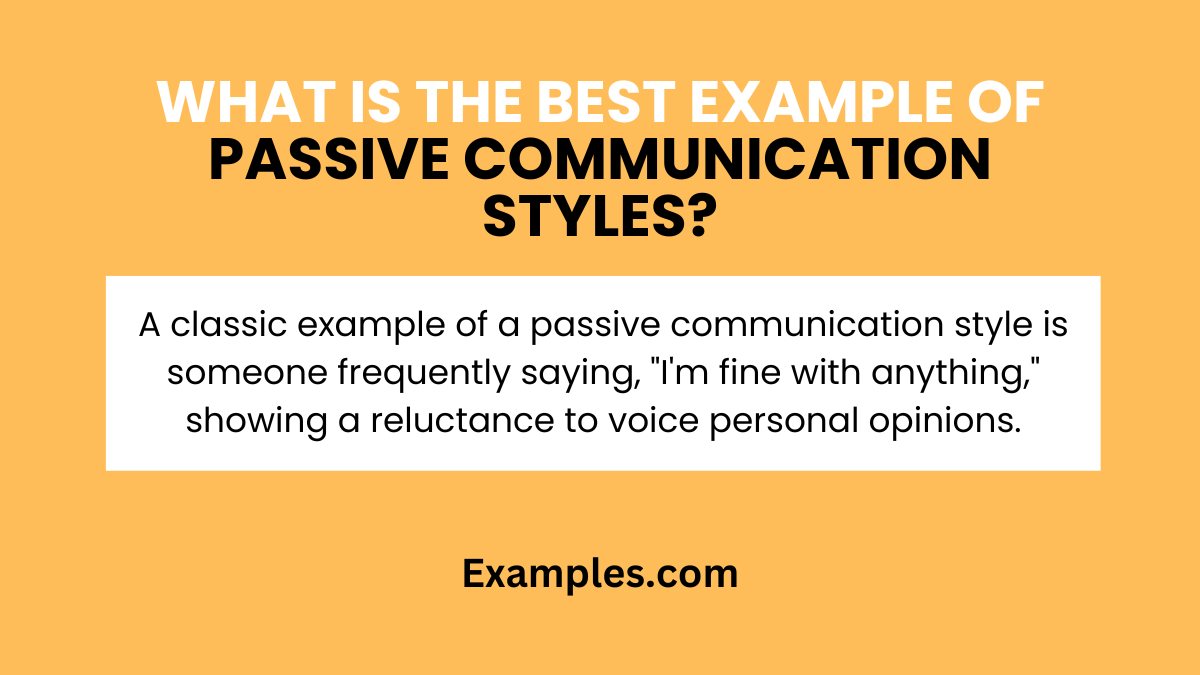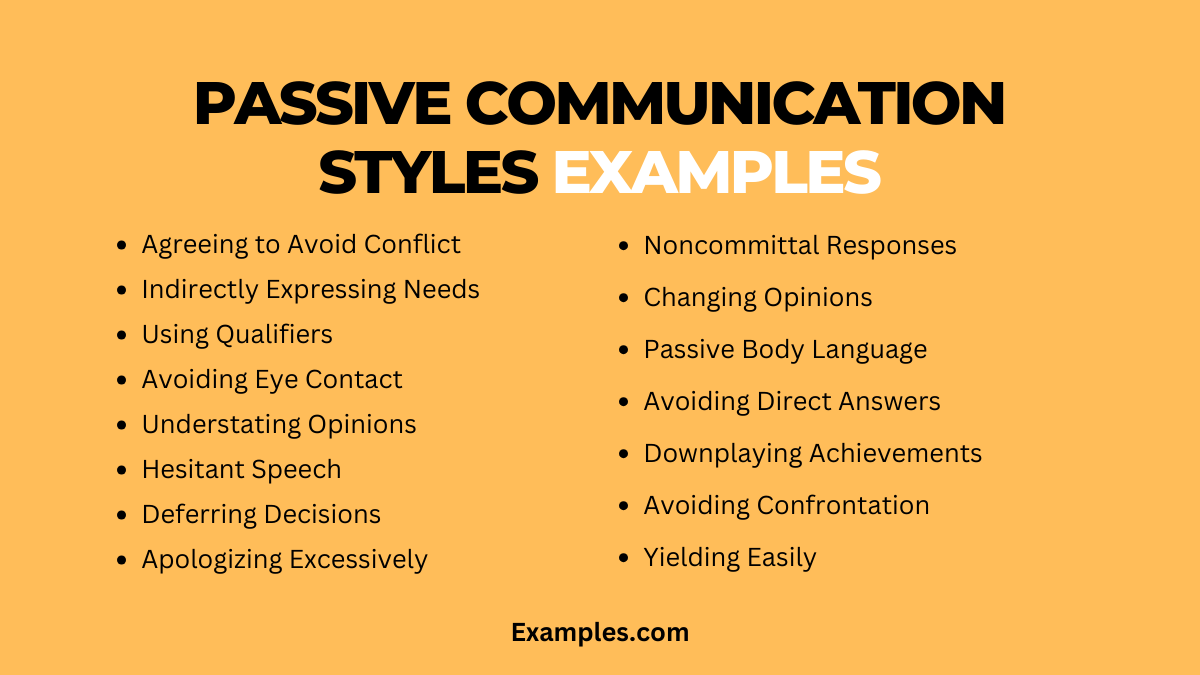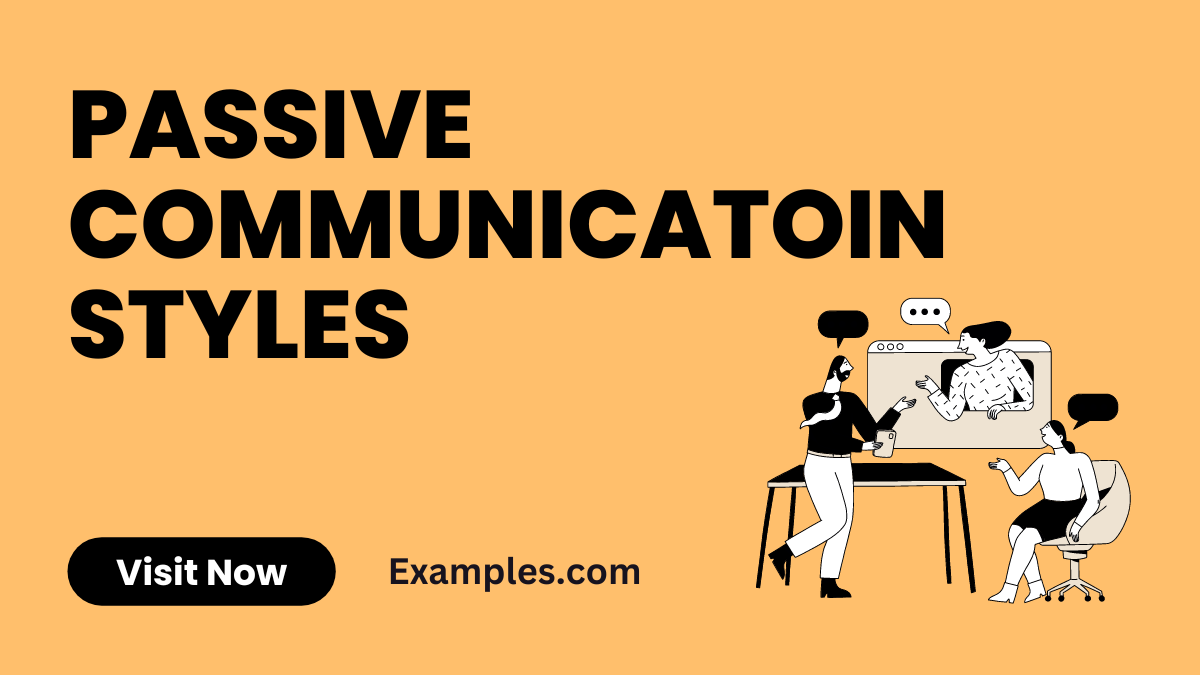14+ Passive Communication Styles Examples
Dive into the world of Passive Communication Styles with this detailed guide. Learn how adopting a more non-confrontational approach can be both therapeutic and effective in various settings. This unique, SEO and NLP-friendly introduction offers insightful examples and practical tips, illustrating how passive communication can be skillfully and constructively used in personal and professional contexts. Enhance your communication skills with nuanced, passive techniques for a harmonious and effective dialogue.
What is the Best Example of Passive Communication Styles?

A classic example of Passive Communication Styles is when a person consistently agrees to others’ suggestions without voicing their own preferences. For instance, in a team meeting, if a member repeatedly says, “Whatever you think is best,” or “I’m fine with anything,” they demonstrate passive communication. This reflects a reluctance to express personal opinions or engage in potential conflict, often leading to a scenario where their own needs and ideas remain unaddressed. While it can create a temporary sense of harmony, this style can also lead to long-term issues such as ineffective communication and dissatisfaction.
15 Passive Communication Styles Examples

Uncover the subtleties of Passive Communication Styles with our expert guide. This SEO and NLP-optimized description delves into 15 distinct examples of passive communication, illustrating how this style manifests in everyday interactions. Each example is accompanied by a brief explanation and a practical communication sentence, offering a clear understanding of how passive communication can influence various aspects of personal and professional life. Enhance your communication skills and awareness with these carefully chosen scenarios.
- Agreeing to Avoid Conflict Often saying yes to avoid disagreements.
Example: “Sure, whatever you think is best.” - Indirectly Expressing Needs Hinting at needs instead of stating them directly.
Example: “I guess I’ll just handle this myself, as usual.” - Using Qualifiers Softening statements to appear less assertive.
Example: “I’m not sure, but maybe we could try a different approach?” - Avoiding Eye Contact Lack of eye contact to avoid confrontation.
Example: Communicating while looking away or down. - Understating Opinions Minimizing own views to keep peace.
Example: “Well, I suppose it could be okay.”

- Hesitant Speech Using fillers or hesitations indicating uncertainty.
Example: “Umm, I don’t know, maybe we should think about it?” - Deferring Decisions Letting others make decisions to avoid taking a stand.
Example: “You decide; I’m fine with anything.” - Apologizing Excessively Frequent unnecessary apologies.
Example: “Sorry, but can I add something?” - Noncommittal Responses Giving vague answers to avoid commitment.
Example: “I’m not sure, let’s see how it goes.” - Changing Opinions Easily swayed to match others’ viewpoints.
Example: “I thought so too, but if you think differently, I can agree.” - Passive Body Language Slouched posture or lack of assertiveness in presence.
Example: Communicating with a slouched posture.

- Avoiding Direct Answers Circumventing direct answers to evade clear stance.
Example: “Well, there are many ways to look at it.” - Downplaying Achievements Underplaying personal achievements or strengths.
Example: “It was nothing, anyone could have done it.” - Avoiding Confrontation Stepping away from potentially contentious discussions.
Example: “Let’s not talk about it right now.” - Yielding Easily Quickly conceding in disagreements to maintain harmony.
Example: “Okay, you’re right. Let’s do it your way.”
Passive Communication Styles in the Workplace

- Agreeing to All Proposals Consistently agreeing to ideas without voicing personal insights.
Example: “Yes, that plan works for me, even if it’s not the best option.” - Not Voicing Concerns Hesitation to raise concerns or objections.
Example: “I suppose I could work late again, even though it’s difficult for me.” - Indirectly Seeking Help Hinting at needing assistance instead of asking directly.
Example: “It’s tough to manage this project alone, isn’t it?” - Avoiding Leadership Roles Stepping back from taking charge or leading.
Example: “I think someone else would be better suited for leading this project.” - Minimizing Contributions Downplaying one’s own contributions or ideas.
Example: “I just did a small part, it’s not a big deal.”
What are the Characteristics of Passive Communication Styles?
- Avoidance of Confrontation: Individuals preferring passive communication tend to avoid conflicts, prioritizing harmony over their own needs.
- Non-Assertiveness: There’s a significant lack of assertiveness, with a tendency to comply with others’ requests or opinions, even if it means sacrificing personal interests.
- Indirect Expression of Needs and Desires: Passive communicators often hint at their needs rather than stating them clearly, which can lead to misunderstandings and ineffective communication.
- Submissive Body Language: Nonverbal cues, such as avoiding eye contact or slouched posture, are common, reflecting a lack of confidence in expressing themselves.
- Low Self-Esteem: Often, passive communicators may have lower self-esteem, which manifests in their communication style as hesitancy to assert themselves.
Types of Passive Communication Styles
- The People Pleaser: This type avoids conflict at all costs, agreeing with others to maintain peace, often at the expense of their own opinions.
- The Apologizer: Characterized by excessive apologizing, this style reflects a lack of self-assurance and a tendency to assume blame, even when unnecessary.
- The Avoider: They avoid direct communication, especially in potentially contentious situations, leading to communication barriers.
- The Hesitant Communicator: Marked by frequent hesitations and uncertainty in speech, they often struggle to articulate their thoughts confidently.
- The Silent Agree-er: Often found in group settings, they nod and agree without contributing their ideas, leading to a lack of diverse perspectives in discussions.
This article offers a comprehensive exploration of Passive Communication Styles, providing valuable examples, guidelines, and tips. It’s an essential read for anyone seeking to understand and navigate these subtle yet impactful communication dynamics in personal and professional settings. Armed with this knowledge, readers can enhance their communication skills, fostering more effective and empathetic interactions in various aspects of life.
14+ Passive Communication Styles Examples

Dive into the world of Passive Communication Styles with this detailed guide. Learn how adopting a more non-confrontational approach can be both therapeutic and effective in various settings. This unique, SEO and NLP-friendly introduction offers insightful examples and practical tips, illustrating how passive communication can be skillfully and constructively used in personal and professional contexts. Enhance your communication skills with nuanced, passive techniques for a harmonious and effective dialogue.
What is the Best Example of Passive Communication Styles?

A classic example of Passive Communication Styles is when a person consistently agrees to others’ suggestions without voicing their own preferences. For instance, in a team meeting, if a member repeatedly says, “Whatever you think is best,” or “I’m fine with anything,” they demonstrate passive communication. This reflects a reluctance to express personal opinions or engage in potential conflict, often leading to a scenario where their own needs and ideas remain unaddressed. While it can create a temporary sense of harmony, this style can also lead to long-term issues such as ineffective communication and dissatisfaction.
15 Passive Communication Styles Examples

Uncover the subtleties of Passive Communication Styles with our expert guide. This SEO and NLP-optimized description delves into 15 distinct examples of passive communication, illustrating how this style manifests in everyday interactions. Each example is accompanied by a brief explanation and a practical communication sentence, offering a clear understanding of how passive communication can influence various aspects of personal and professional life. Enhance your communication skills and awareness with these carefully chosen scenarios.
Agreeing to Avoid Conflict Often saying yes to avoid disagreements.
Example: “Sure, whatever you think is best.”Indirectly Expressing Needs Hinting at needs instead of stating them directly.
Example: “I guess I’ll just handle this myself, as usual.”Using Qualifiers Softening statements to appear less assertive.
Example: “I’m not sure, but maybe we could try a different approach?”Avoiding Eye Contact Lack of eye contact to avoid confrontation.
Example: Communicating while looking away or down.Understating Opinions Minimizing own views to keep peace.
Example: “Well, I suppose it could be okay.”

Hesitant Speech Using fillers or hesitations indicating uncertainty.
Example: “Umm, I don’t know, maybe we should think about it?”Deferring Decisions Letting others make decisions to avoid taking a stand.
Example: “You decide; I’m fine with anything.”Apologizing Excessively Frequent unnecessary apologies.
Example: “Sorry, but can I add something?”Noncommittal Responses Giving vague answers to avoid commitment.
Example: “I’m not sure, let’s see how it goes.”Changing Opinions Easily swayed to match others’ viewpoints.
Example: “I thought so too, but if you think differently, I can agree.”Passive Body Language Slouched posture or lack of assertiveness in presence.
Example: Communicating with a slouched posture.

Avoiding Direct Answers Circumventing direct answers to evade clear stance.
Example: “Well, there are many ways to look at it.”Downplaying Achievements Underplaying personal achievements or strengths.
Example: “It was nothing, anyone could have done it.”Avoiding Confrontation Stepping away from potentially contentious discussions.
Example: “Let’s not talk about it right now.”Yielding Easily Quickly conceding in disagreements to maintain harmony.
Example: “Okay, you’re right. Let’s do it your way.”
Passive Communication Styles in the Workplace

Agreeing to All Proposals Consistently agreeing to ideas without voicing personal insights.
Example: “Yes, that plan works for me, even if it’s not the best option.”Not Voicing Concerns Hesitation to raise concerns or objections.
Example: “I suppose I could work late again, even though it’s difficult for me.”Indirectly Seeking Help Hinting at needing assistance instead of asking directly.
Example: “It’s tough to manage this project alone, isn’t it?”Avoiding Leadership Roles Stepping back from taking charge or leading.
Example: “I think someone else would be better suited for leading this project.”Minimizing Contributions Downplaying one’s own contributions or ideas.
Example: “I just did a small part, it’s not a big deal.”
What are the Characteristics of Passive Communication Styles?
Avoidance of Confrontation: Individuals preferring passive communication tend to avoid conflicts, prioritizing harmony over their own needs.
Non-Assertiveness: There’s a significant lack of assertiveness, with a tendency to comply with others’ requests or opinions, even if it means sacrificing personal interests.
Indirect Expression of Needs and Desires: Passive communicators often hint at their needs rather than stating them clearly, which can lead to misunderstandings and ineffective communication.
Submissive Body Language: Nonverbal cues, such as avoiding eye contact or slouched posture, are common, reflecting a lack of confidence in expressing themselves.
Low Self-Esteem: Often, passive communicators may have lower self-esteem, which manifests in their communication style as hesitancy to assert themselves.
Types of Passive Communication Styles
The People Pleaser: This type avoids conflict at all costs, agreeing with others to maintain peace, often at the expense of their own opinions.
The Apologizer: Characterized by excessive apologizing, this style reflects a lack of self-assurance and a tendency to assume blame, even when unnecessary.
The Avoider: They avoid direct communication, especially in potentially contentious situations, leading to communication barriers.
The Hesitant Communicator: Marked by frequent hesitations and uncertainty in speech, they often struggle to articulate their thoughts confidently.
The Silent Agree-er: Often found in group settings, they nod and agree without contributing their ideas, leading to a lack of diverse perspectives in discussions.
This article offers a comprehensive exploration of Passive Communication Styles, providing valuable examples, guidelines, and tips. It’s an essential read for anyone seeking to understand and navigate these subtle yet impactful communication dynamics in personal and professional settings. Armed with this knowledge, readers can enhance their communication skills, fostering more effective and empathetic interactions in various aspects of life.


